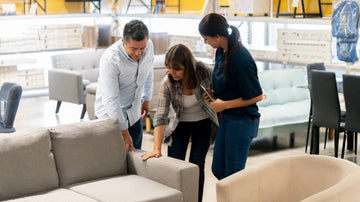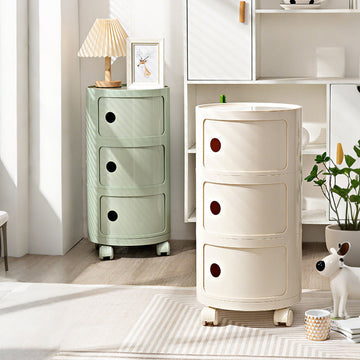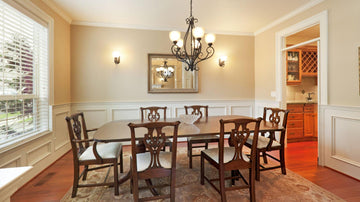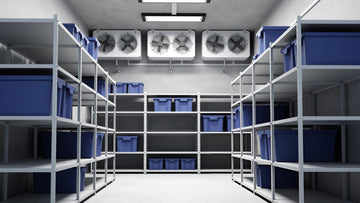Table of Contents
- Introduction
- Fabric Isn’t Just About Touch—It’s About How You Live
- Leather Sofas: Built to Last, But Not Always Built for You
- Fabric Sofas: Comfortable, Customizable, and Real-Life Ready
- Faux Leather: Better Than It Used to Be (But Not Quite Leather)
- Which One's Right for You?
- A Few Scenarios, Just to Make It Easier
- A Note on What’s Changing
- Final Thoughts
You’d think buying a sofa would be straightforward. You go to a store, sit on a few, pick the one that doesn’t poke your back or swallow you whole, and call it a day.
Then suddenly, you’re reading about top-grain versus full-grain leather, wondering if “performance fabric” means it can survive your toddler, and trying to picture whether “olive green velvet” is timeless or a Pinterest mistake. It gets complicated fast.
But here’s the thing: the fabric you choose isn’t just about looks. It changes how the sofa feels day to day, how long it lasts, and whether it fits into your actual life—or fights against it every time someone drops a snack.
So let’s put the marketing aside and talk real. Leather, fabric, and faux leather all have their place. But they live very differently once they’re in your home.
Fabric Isn’t Just About Touch—It’s About How You Live
Take a second and think: how do you actually use your sofa?
Do you eat dinner on it more often than at your table? Do your pets think it’s their bed? Do you fall asleep there twice a week with the TV still on? If you answered yes to any of those, you’re not alone—and the fabric you choose should work with that, not against it.
A sofa isn’t just furniture. It’s your downtime zone. The place where your kids climb, your dog sheds, your guests sit, and your coffee might occasionally spill. So while color and shape matter, the fabric is what makes or breaks your experience over time.
And no, there’s no perfect material. But there is a right fit for your habits.

Leather Sofas: Built to Last, But Not Always Built for You
Let’s start with the classic. Leather has a reputation—and for good reason. It looks polished, smells expensive, and, if you buy the good stuff, it can outlive most of your other furniture.
But there’s more to it than “leather is good.” There are levels.
Full-grain leather is the real thing. Thick, textured, and untreated. You’ll see natural scars and marks—and that’s the point. Over time, it softens and darkens in a way that feels personal. It’s the leather equivalent of a well-worn leather jacket. Not perfect, but better because of it.
Top-grain leather is cleaner, more uniform, and a little easier to manage. It’s sanded to remove rough spots and often treated to resist stains. If full-grain is rustic charm, top-grain is city smart.
Split leather is... the budget version. It’s made from the lower layers of the hide. At first glance, it looks okay. But give it a couple years, and you’ll probably start to see cracking or peeling, especially if it's in a sunny or high-use spot.
Also, let’s not ignore the origin. Italian leather has a well-earned rep—soft, durable, and beautifully finished. Domestic leather can be great too, but it’s more hit-and-miss depending on the brand.
The Leather Lifestyle
Living with a leather sofa is kind of like owning a vintage car. It looks amazing. It lasts forever. But it needs some love. You’ll have to condition it now and then, maybe wince when your cat jumps on it, and probably throw a blanket over it if it’s freezing in winter or sticky in summer.
That said, if you appreciate things that age well, don’t mind a bit of care, and love a classic look, leather could be your forever sofa.

Fabric Sofas: Comfortable, Customizable, and Real-Life Ready
Fabric is... friendly. That’s the best way to put it.
It doesn’t try too hard. It doesn’t need to be babied. And it offers way more options—colors, textures, patterns, even feel. You want soft and nubby? Done. Smooth and cool? Also doable.
But not all fabrics are created equal. A few common types:
-
Cotton & linen: Natural, breathable, great for casual vibes. The downside? They stain easily and can wrinkle if you even look at them wrong.
-
Velvet: Yes, it’s luxurious. Yes, it’s dramatic. But it also shows every hair, crumb, and crease. Prepare to lint-roll often.
-
Blends: The sweet spot for many. A mix of natural and synthetic fibers gives you the best of both worlds—strength, softness, and better stain resistance.
-
Performance fabrics: These are engineered to take abuse—spills, claws, sticky fingers. If your house is a whirlwind of kids or pets, performance fabric might be your new best friend.
What It’s Like to Live With Fabric
Fabric feels warm. It invites you to flop down, curl up, stretch out. It doesn’t judge if you spill popcorn or wear pajama pants all Sunday.
But it has its downsides. Some fabrics fade if they sit in the sun too long. Others start to sag or pill over time. And light colors? Beautiful, but they make every stain a headline.
Still, if you like comfort, want options, and aren’t afraid of a little upkeep (or buying a good upholstery cleaner), fabric is a solid, practical choice.
Bonus: many fabric sofas come with removable covers. That means you can wash them—or swap them out for a whole new look later. Instant refresh, no new sofa required.

Faux Leather: Better Than It Used to Be (But Not Quite Leather)
Faux leather gets a bad rap, and sometimes it deserves it. But newer versions have come a long way.
First, the types:
-
PU (polyurethane): Softer, more flexible, and generally better-feeling than it sounds.
-
PVC (polyvinyl chloride): Tough and water-resistant, but can feel stiff and plasticky.
-
Microfiber leather: A newer option that’s surprisingly convincing. Looks close to the real thing, feels decent, and holds up okay.
The Appeal
-
It’s affordable. Faux leather costs way less than the real deal.
-
It’s low maintenance. Spills? Wipe and move on.
-
It’s scratch-resistant—well, more than leather in many cases.
-
It’s animal-free. For vegans or buyers who prefer cruelty-free products, that matters.
The Trade-Offs
But let’s be honest. Faux leather doesn’t breathe. In hot weather, it gets sticky. In cold weather, it can feel stiff. And over time, especially with cheaper versions, it cracks. Not gracefully, either.
If you’re furnishing a guest room, a short-term rental, or working with a tighter budget, faux leather is worth considering. Just know what you’re getting—and don’t expect it to age like real leather.
Which One's Right for You?
Instead of picking “the best” material, think about which one makes your life easier—not harder.
Ask yourself:
-
Who’s using the sofa (really)? If it’s your kids’ jungle gym, durability comes first.
-
How often do you want to clean it? Be honest.
-
Do you care if it scratches? If yes, maybe skip leather—or invest in throws.
-
Do you want to change the look easily? Fabric with slipcovers wins here.
-
Is this your long-term sofa or a “for now” piece?
There’s a reason no single material works for everyone. Your sofa should match your habits, not some trend you saw on Instagram.
A Few Scenarios, Just to Make It Easier
-
You’ve got toddlers and a dog → Performance fabric or good faux leather. Leather will break your heart here.
-
You host often and love a statement piece → Top-grain leather or velvet (if you're okay with upkeep).
-
You spill things a lot and hate cleaning → Faux leather, hands down.
-
You redecorate every two years → Neutral fabric with swappable covers.
-
You want one sofa to last a decade (or two) → Full-grain leather. Pricey now, but pays off long-term.
A Note on What’s Changing
Sustainable fabric options are growing—recycled polyester, organic cotton, even plant-based leathers. Some brands now offer sofas with FSC-certified wood frames, water-based glues, and OEKO-TEX fabrics. If that matters to you, it’s worth asking.
Also: performance fabrics are no longer ugly. They used to feel like plastic. Now? You’d never know they’re built to survive grape juice and dog drool.
Final Thoughts
Your sofa is more than a prop—it’s where real life happens. So pick a fabric that fits your version of “real.” That might mean spending more now to get something that lasts. Or choosing something budget-friendly that does the job without stress.
Whatever you choose, go sit on it in person if you can. Feel it. Picture it in your living room with your people, your routines, your messes. That’s the test that matters—not the catalog photo.
And if you’re still stuck between leather and fabric? You’re not alone. Just don’t rush. You’re not buying a sandwich. You’re buying your next nap spot.








